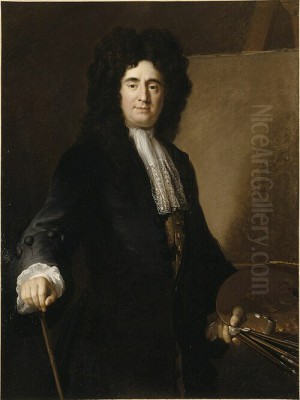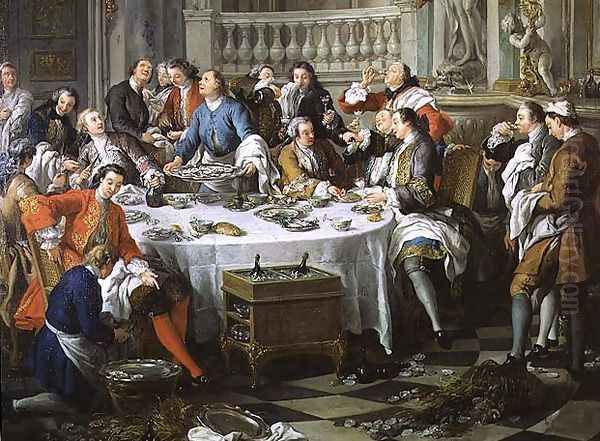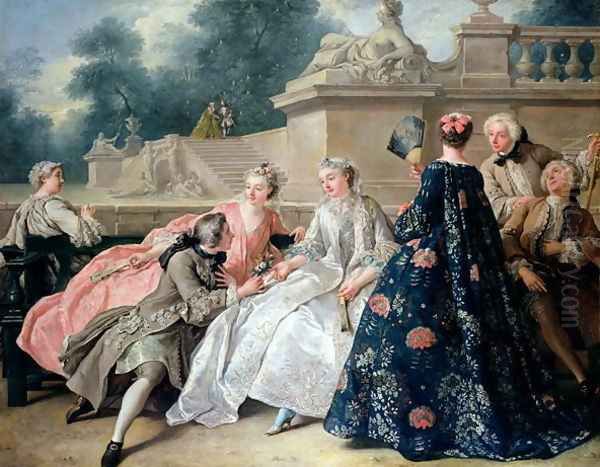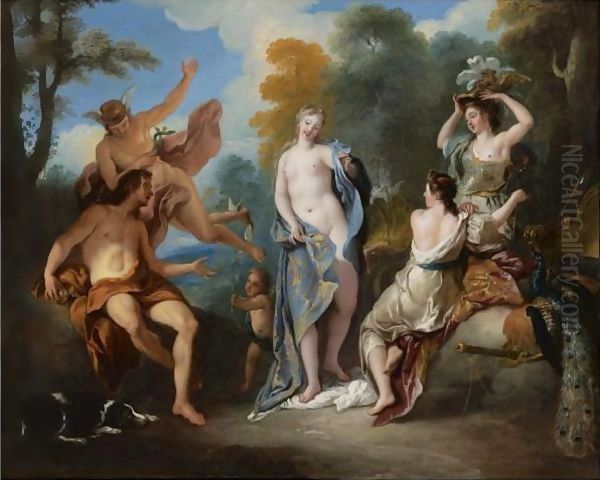
François de Troy (1645–1730) stands as a significant figure in French art history, a painter and engraver whose career gracefully navigated the transition from the grandeur of the late Baroque, heavily influenced by the reign of Louis XIV, towards the burgeoning elegance and intimacy of the Rococo style. Born in Toulouse into an artistic family, he rose to prominence in Paris, becoming a favoured portraitist of the French aristocracy and royalty, a respected member and eventual Director of the prestigious Académie Royale de Peinture et de Sculpture. His work, primarily focused on portraiture but also encompassing history painting and decorative schemes, offers a vivid window into the opulent world of the French elite at the turn of the 18th century.
Artistic Foundations in Toulouse and Paris
François de Troy's artistic journey began in Toulouse, a major cultural centre in southern France. He was born in 1645, the son of Nicolas de Troy (c. 1608–1684), himself a painter of some repute in Toulouse, associated with the city's guild and known for religious works and portraits. This familial connection undoubtedly provided François with his initial exposure to the techniques and profession of painting. His brother, Jean de Troy (1638–1691), also became a painter, further cementing the family's artistic identity.
Seeking broader opportunities and more advanced training, the young François moved to Paris likely in the early 1660s. The capital was the undisputed centre of artistic patronage and academic training in France, dominated by the influence of the Académie Royale, founded in 1648. In Paris, de Troy is believed to have studied with painters such as Claude Lefèbvre (1632–1675), a notable portraitist known for his sober realism, and possibly Nicolas-Pierre Loir (1624–1679), a versatile artist skilled in both history painting and decorative work. This training grounded him in the established traditions of French painting, particularly in the demanding art of portraiture.
Italian Influences and Academic Recognition

While the exact chronology and duration of his travels remain debated by historians, it is widely accepted that François de Troy spent time in Italy, the essential destination for any ambitious European artist of the period. Unlike some contemporaries who won the coveted Prix de Rome scholarship for extended study, de Troy's Italian sojourn may have been undertaken independently. Regardless of the circumstances, this experience was crucial in broadening his artistic horizons.
In Italy, particularly in Rome and potentially Venice, de Troy would have absorbed the lessons of the Italian masters. The rich colours and dramatic compositions of the Venetian school, exemplified by artists like Titian (Tiziano Vecellio) and Paolo Veronese, likely left a mark on his palette and sense of composition. Furthermore, the enduring influence of Baroque masters, perhaps even the lingering impact of Caravaggio's dramatic naturalism, and the classical ideals revived by artists associated with the Roman academies, would have contributed to his development. The elegance and courtly grace found in the works of Flemish masters like Peter Paul Rubens and Anthony van Dyck, whose influence permeated European portraiture, were also significant reference points.
Upon his return to Paris, de Troy sought official recognition. He was received (agréé) by the Académie Royale in 1671 and became a full member in 1674. His reception piece, the painting required to demonstrate his skill and secure membership, was Mercury Cutting off the Head of Argus. This acceptance into the Academy was a critical step, granting him access to royal commissions and placing him within the official hierarchy of French art.
A Celebrated Portraitist
Portraiture became the cornerstone of François de Troy's career and reputation. He excelled in capturing not just a likeness, but also the status, elegance, and psychological presence of his sitters. Working during the latter part of Louis XIV's reign and into the Regency period, he catered to the demands of the royal family, the court aristocracy, and wealthy Parisians who wished to be immortalized with fashionable grace.
His style blended realism in facial features with a sophisticated idealization, particularly in the rendering of luxurious fabrics, intricate lace, and powdered wigs. He possessed a talent for flattering his subjects without sacrificing individuality, employing smooth brushwork, rich colour harmonies, and often complex, dynamic poses derived from Baroque traditions but softened with a developing Rococo sensibility. His lighting is typically soft yet effective, highlighting the face and important details of costume and setting.

De Troy operated in a competitive field, with contemporaries like the celebrated Hyacinthe Rigaud (1659–1743) and Nicolas de Largillière (1656–1746) also dominating the portrait market. While Rigaud was renowned for his majestic state portraits, particularly of Louis XIV, and Largillière for his vibrant depictions of the Parisian bourgeoisie and nobility, de Troy carved out his niche with portraits often characterized by a slightly gentler, more intimate, yet still undeniably elegant, approach. He received numerous commissions from the royal family, including portraits of Louis XIV's children and grandchildren, and painted members of the exiled Stuart court of James II of England at Saint-Germain-en-Laye. Notable works include his sensitive Portrait of Charles Mouton, Lute Player (c. 1690), showcasing his ability to capture an artist's introspection, and portraits of prominent figures like the Duchesse du Maine.
History Painting and Grand Decorations
Although primarily known for portraits, François de Troy was also a capable history painter, adhering to the academic hierarchy that placed historical, mythological, and religious subjects at the pinnacle of artistic achievement. His reception piece, Mercury and Argus, demonstrated his proficiency in this genre, showcasing his ability to handle complex multi-figure compositions, dramatic narrative, and the depiction of the nude figure according to classical ideals.
His style in history painting often reflects the influence of Charles Le Brun (1619–1690), the dominant figure in French art during the mid-to-late 17th century and the chief architect of the decorative schemes at Versailles. De Troy's history works exhibit clear composition, expressive gestures, and a rich, often warm palette, aligning with the French classical Baroque tradition.
Beyond easel paintings, de Troy participated in decorative projects for royal and aristocratic residences. While perhaps less extensively involved in monumental schemes than Le Brun or his successors, he contributed to the decoration of châteaux such as Meudon and Saint-Cloud, and potentially worked on commissions for Versailles and Fontainebleau. These projects often involved mythological or allegorical themes designed to flatter the patron and enhance the grandeur of the interior spaces. His versatility allowed him to adapt his style to the demands of both intimate portraiture and large-scale decorative painting.
Pioneering Fashion in Art
François de Troy is sometimes credited, alongside his son Jean-François, with contributing to the development of a new type of painting that focused explicitly on contemporary fashion and social manners – the tableaux de modes (fashion plates or paintings of manners). While his son would more fully develop this genre into lively scenes of aristocratic leisure, François the Elder's group portraits and single-figure depictions already placed a strong emphasis on the accurate and elegant rendering of contemporary dress and social settings.

His group portraits, often depicting families or gatherings, meticulously recorded the details of silk gowns, elaborate hairstyles, lace cuffs, and fashionable accessories. These paintings served not only as records of individuals but also as documents of the prevailing tastes and social rituals of the elite. By integrating detailed representations of fashion so prominently into his portraiture, François de Troy helped pave the way for paintings where the depiction of modern life and its specific styles became a subject in its own right, anticipating the Rococo fascination with elegance, leisure, and the nuances of social interaction.
Academic Career and Influence
François de Troy's standing within the French art world was solidified by his active role in the Académie Royale. Following his reception in 1674, he steadily climbed the academic ladder. He was appointed a Professor in 1693, a position that involved teaching and guiding the next generation of artists according to the Academy's doctrines. His career culminated in his appointment as Director of the Academy in 1708, succeeding the history painter Charles de La Fosse, and he was later re-appointed to the position. He also served as Premier peintre (First Painter) to the exiled King James II of England.
His position as a professor and director meant he exerted considerable influence on artistic training and standards in France. Among his pupils were his own son, Jean-François, who would go on to achieve great fame, and other artists like the portraitist André Bouys (1656–1740). His elegant portrait style, blending Baroque formality with a growing Rococo charm, influenced subsequent portrait painters working in the first half of the 18th century. He was ennobled for his services to the arts, a significant honour reflecting his high status.
The de Troy Dynasty: Father and Son
The artistic legacy of François de Troy is inseparable from that of his family, particularly his son, Jean-François de Troy (1679–1752). Trained by his father, Jean-François also achieved great success, becoming a prominent painter of the Rococo era. While François the Elder excelled primarily in portraiture and history painting within a late Baroque to early Rococo framework, Jean-François became particularly famous for his tableaux de modes – lively, often sensuous scenes depicting aristocratic pastimes, conversations, and flirtations, such as his famous Oyster Lunch (1735) or Declaration of Love (1731).
Jean-François's style, while indebted to his father's technical skill and elegance, fully embraced the lighter palette, dynamic compositions, and playful spirit characteristic of the high Rococo, influenced by contemporaries like Antoine Watteau (1684–1721) and later finding resonance with artists such as François Boucher (1703–1770). Comparing the works of father and son reveals a fascinating evolution in French painting over several decades, moving from the formal dignity associated with Louis XIV's court towards the more intimate and decorative aesthetics favoured during the Regency and the reign of Louis XV. The de Troy family, initiated by Nicolas and brought to prominence by François and Jean-François, represents a significant artistic lineage within French art history.
Later Life and Legacy
François de Troy remained active as a painter well into his later years, adapting his style subtly to changing tastes while retaining his characteristic elegance. His personal life, however, was marked by tragedy; according to contemporary accounts, he endured the loss of his wife, Jeanne Cotelle (sister of the painter Jean Cotelle), and all seven of his children except for his son Jean-François, who survived to continue the family's artistic name.
He died in Paris in 1730, aged 85, leaving behind a substantial body of work and a significant reputation. His legacy lies in his mastery of portraiture, providing a visual record of the French elite during a pivotal period of transition. He skillfully bridged the gap between the formal Baroque portraiture of the 17th century and the emerging Rococo style, infusing his works with a blend of realism, elegance, and psychological insight. His contributions to history painting and decorative arts, along with his influential role within the Académie Royale, further solidify his importance.
Today, François de Troy's paintings are held in major museum collections around the world, including the Louvre Museum and Musée Carnavalet in Paris, the Palace of Versailles, the Musée Condé in Chantilly, the Uffizi Gallery and Pitti Palace in Florence, the Victoria and Albert Museum in London, and numerous other institutions in France and abroad. His work continues to be studied for its artistic quality, its historical significance as a document of its time, and its place within the rich tapestry of French painting.